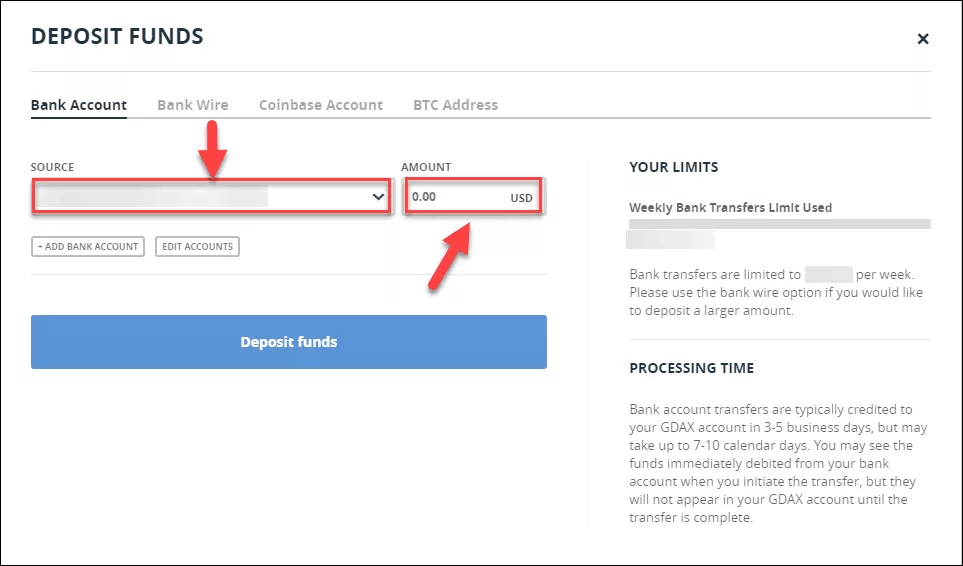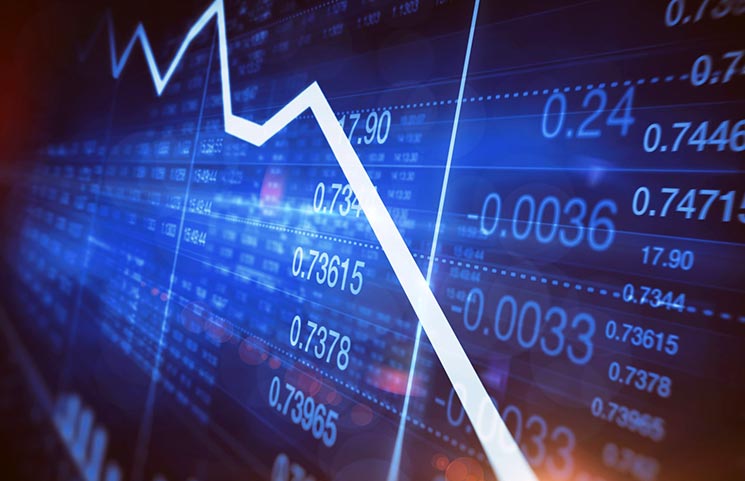Cryptocurrency Information
GDAX: How To Trade Using Coinbase’s Global Digital Asset Exchange
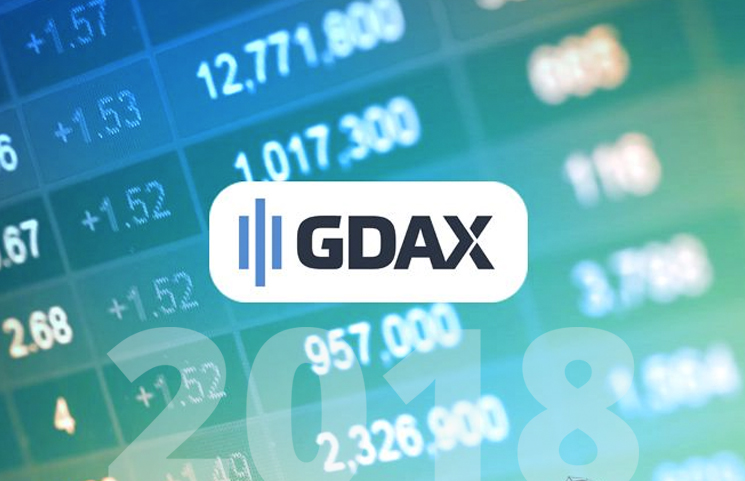
The Global Digital Asset Exchange (GDAX), one of the most famous Bitcoin and cryptocurrency trading exchanges in the world, launched by the Coinbase team in May of 2016, aimed at more advanced users and professional traders.
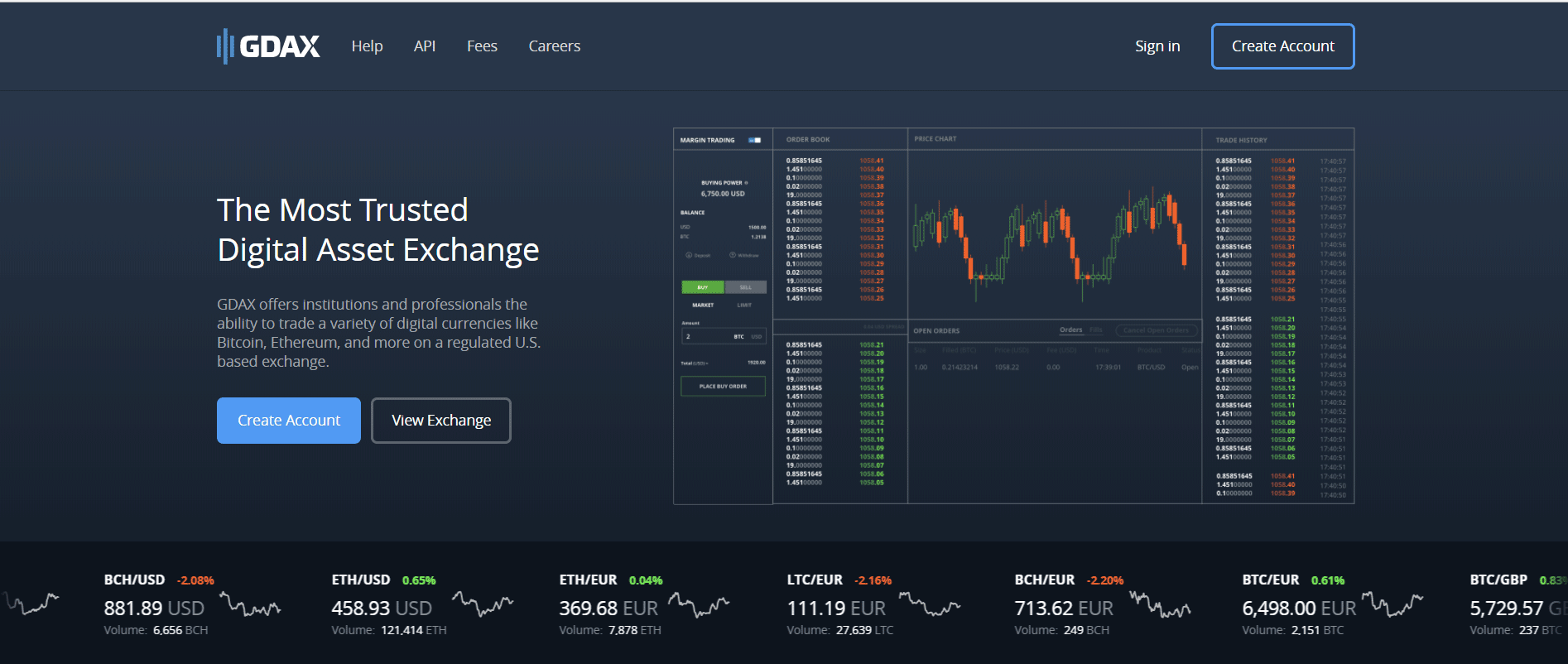
What Is GDAX?
Global Digital Asset Exchange, abbreviated to GDAX, is one of the world’s most popular places for the exchange of cryptocurrencies. It is run by the same company that owns Coinbase headquartered in San Francisco. As a regulated US-based exchange, GDAX is insured and backed by some of the biggest investors in the industry like the New York Stock Exchange (NYSE), Andreessen Horowitz, and Union Square Ventures.
Over the years, GDAX has hailed to one of the biggest cryptocurrency exchanges due to its extreme liquidity. It offers advanced trading features, competitive fees, and varieties of deposit options. The exchange allows traders to leverage up to 500:1. Most importantly, GDAX offers FDIC insurance to customers, which means, in the case of loss of funds by the exchange, a customer might be entitled to up to $250,000 in remuneration depending on the sum of the customer’s assets.
Table Of Contents
Features Of GDAX
The following are the most common features of the exchange:
Margin Trading
One of the remarkable features of the exchange compared to other exchanges, is its margin trading options. Once you are set to trade margin through GDAX, the amount of leverage you can access depends on which currency pair you want to trade. GDAX bids margin trading with leverage up to 3x on BTC/USD and ETH/USD pairs, up to a limit of $10,000, or 2x for BTC/EUR pair up to 3,000 EUR, and up to $500 for LTC/USD pair.
If you are willing to use on-loan money to trade cryptocurrencies through GDAX, you have to enable margin trading at the top of the margin trading panel. For BTC/USD, you can leverage as high as 3x. Meaning, if the combined value of your BTC and USD balances sums to a total of $3,000, you can purchase or sell $9,000 worth of BTC/USD.
Fluent Design
The ease-of-use feature offered by GDAX makes it one of the most sort-after exchange. GDAX presents user with an instinctive UI, with instantaneous order books, monitoring tools, trade history, and a simple order processing tools that enables every customer to trade easily, regardless of having previous experience or not. The interface is well-organized, so that traders will not have any difficulty with finding what is needed, whether it is trading history, tools, or help.
API Support
Like some other exchanges, GDAX offers a Websocket feed that lets traders easily gain access to real-time market data. The trading API also allows for the development of secure trading bots.
GDAX’s abundant trading API offers an effective way for developers to build digital asset trading bots/applications, to track the market, view trading history, monitor open orders, and more, so as to offer related functionalities of the exchange. The followings outline exceptional properties of the GDAX’s API
- A customizable, WebSocket-synced Order Book implementation
- API clients with convenient methods for every API endpoint
- Preoccupied interfaces that allows you to worry-less about HMAC signing or JSON formatting.
Security
GDAX uses PGP encryption to secure customers transaction data. Also, 98% of the customers’ funds are locked in cold storage using multi-signature keys and encryptions.
Fee Structure
There are no fees for making deposits and withdrawals from GDAX account. Only bank fees apply in the case of Wire transfers. GDAX offers 0% maker fees and taker fees as low as 0.1%. There’s also a discount of 0.01 percent for the takers at the end of each day. According to the exchange, the below table summarizes fee structure of the percentage of a 30-day volume.
| 0 percent (~0 BTC) | 0.25 percent fee |
| 1 percent (~2,114 BTC) | 0.24 percent fee |
| 2.5 percent (~5,287 BTC) | 0.22 percent fee |
| 5 percent (~10,574 BTC) | 0.19 percent fee |
| 10 percent (~21,148 BTC) | 0.15 percent fee |
| 10 percent (~42,297 BTC) | 0.10 percent fee |
Multiple Currency Pairs
Currently, the exchange supports these FIAT currencies:
- USD
- EUR
- GBP
Also, when it comes to digital currencies, the three matching currencies available are:
GDAX offers a wide range of fiat and cryptocurrency pairs, including BTC/USD, ETH/USD, LTC/EUR, LTC/USD, ETH/BTC, LTC/BTC, BTC/GBP, and BTC/EUR, among others.
There are no limits when it comes to trading or deposits. However, there is a limit of 50,000 US dollars per week for withdrawals, but it’s not affected by the verification. Depending on the country, available trading pairs can vary. Some of the most popular regions available are:
- US – BTC/USD, ETH/USD, ETH/BTC, LTC/USD, LTC/BTC
- Canada – ETH/BTC, LTC/BTC
- Europe – BTC/EUR, ETH/BTC, LTC/BTC
- The United Kingdom – BTC/GBP, ETH/BTC, LTC/BTC
- Australia – ETH/BTC, LTC/BTC
- Singapore – ETH/BTC, LTC/BTC
The full guide can be found on GDAX support page here.
Support
GDAX has a very extensive FAQ page and also offers ticket submission and email support. According to the reviews from majority of the users, the support team usually respond to users’ need within 48 hours.
Getting Started With GDAX
Account Registration
To sign up and create your account with GDAX, follow these steps:
- Simply navigate to gdax.com from your web browser.
Note: As a security measure, make sure the Green padlock symbol is shown in your browser address bar, and the protocol is HTTPS, not just HTTP.
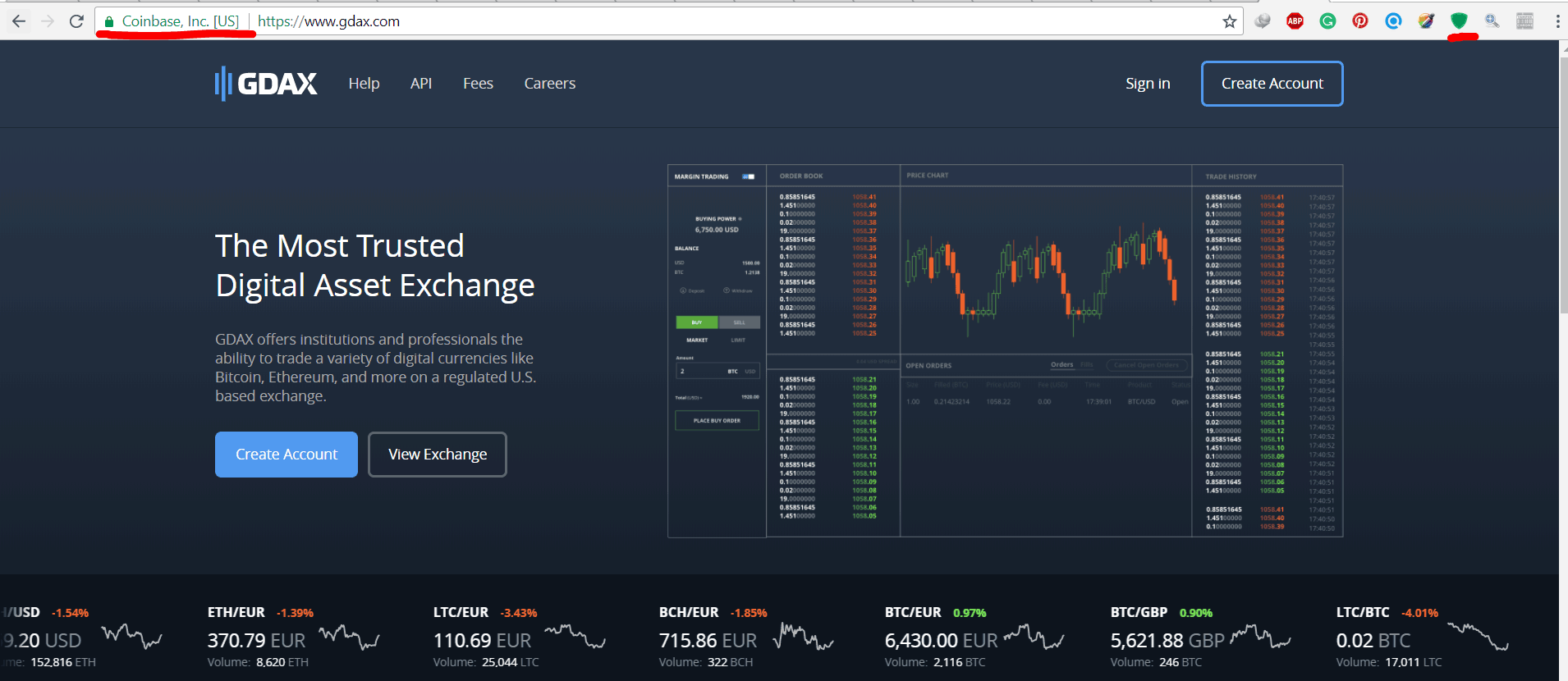
Select “Create Account“.
- Complete the sign-up form, then click the “Create an account” button
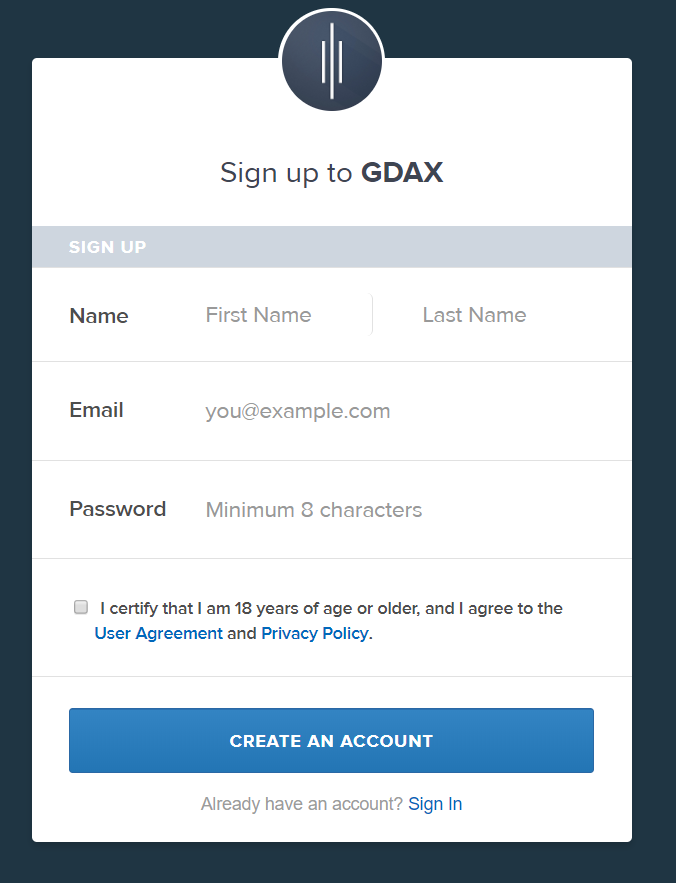
- Check your inbox in the mail you provided, and click the verification link sent to your email address.
- After verifying your email address, you will be asked to provide a phone number.
- Specify whether you would like to create an ‘Individual'or ‘Institutional' Depending on the account type selected, you will need to provide information about yourself or your institution.
Account Verification
Users who are already registered on Coinbase don’t have to create an account from scratch and can log in with their Coinbase credentials.
However, GDAX requires two level identity verification for new users. The verification is necessary, and users are not allowed to place deposits or trade before the verification process is completed. So, depending on the location, GDAX has an option for individuals and institutions, whereby you have to fill in the details during registration. The rest of the steps mainly involve verifying your identity and residence, in an effort to increase compliance with the available rules.
The following are the requirements for US users alone:
- Photo of a state ID or driver’s license
- The residential address
- Social Security number (SSN)
For users in the UK:
- A photo of an ID card, driver’s license or Passport.
- The answer to a couple of identity questions
For other users (Singapore, Australia, Canada and European countries):
- A photo of an ID card, driver’s license or Passport.
- Another photo of a different ID document.
Funding your GDAX account
GDAX currently accepts Bank transfers. Credit/Debit Card deposits can also be made via Coinbase (since Coinbase users also have a free access to a GDAX account). However, there is no information on the minimum initial deposit on GDAX.
Note that according to the GDAX support, Bank Account deposits made to GDAX are sent via the ACH bank transfer system, which typically takes 3-5 business days (which can be as many as 7-10 calendar days, depending on the timing of weekends and other bank holidays) to complete after initiating a purchase.
There are four basic options for making a deposit, which are:
- Bank Account
- Bank Wire
- Coinbase Account
- BTC/ETH/BCC/LTC Address.
USING BANK ACCOUNT
- Select the bank account from the “Source” field and enter the amount you want to deposit
- Click the “Deposit funds” button
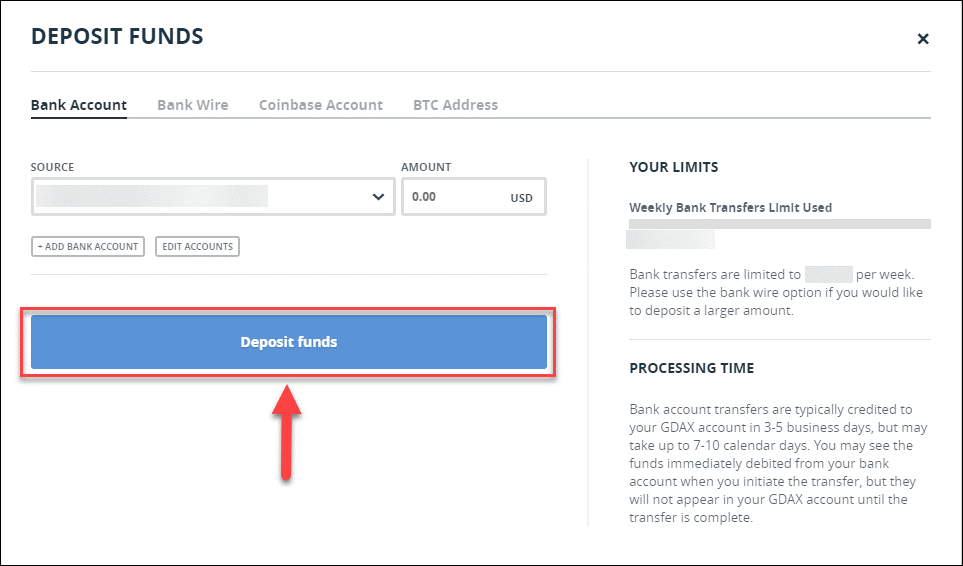
USING BANK WIRE
- Give the information they provide to your bank to have a wire transfer Wire transfers are good if you need to send more than your weekly limit.
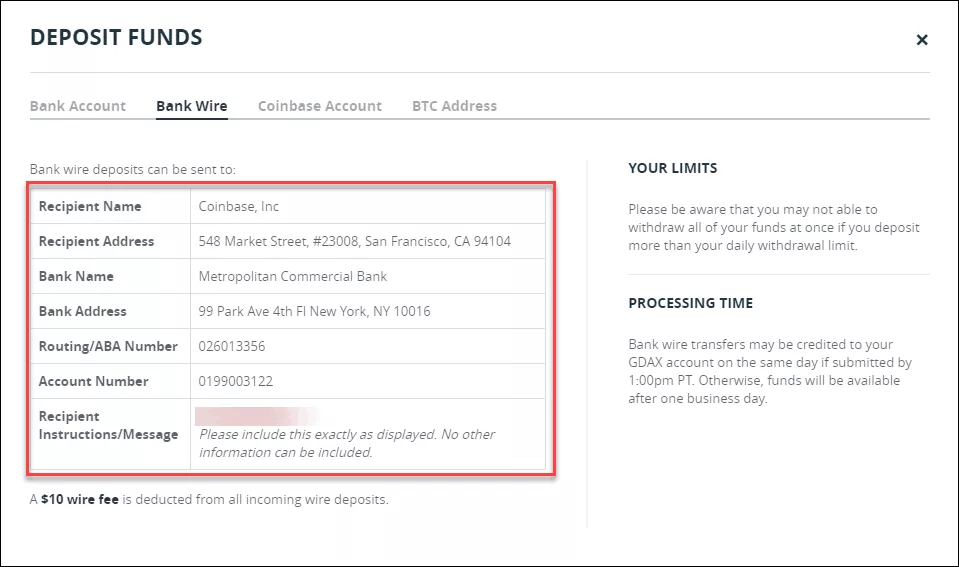
USING COINBASE ACCOUNT
- Select the Coinbasewallet you want to transfer from and enter an amount. Note that since BTC was selected in step 2 that it will only show my BTC and USD Note that transfer is instant and free between Coinbase and GDAX!
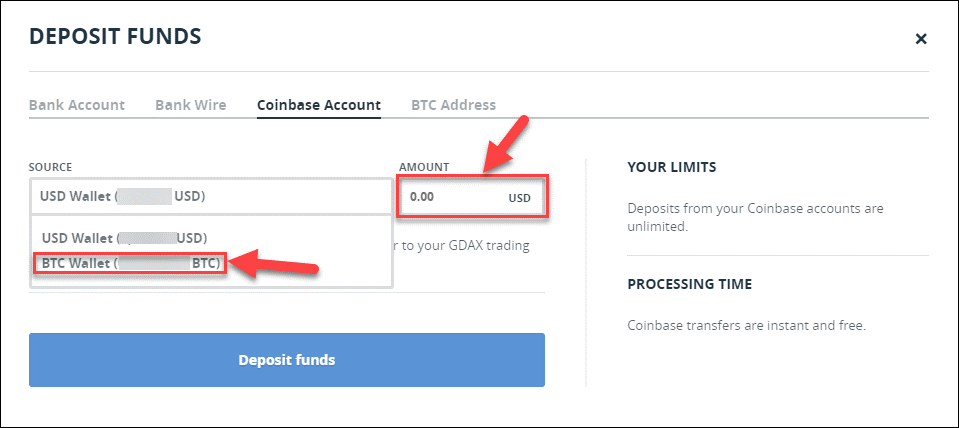
- Click the “Deposit Funds” button
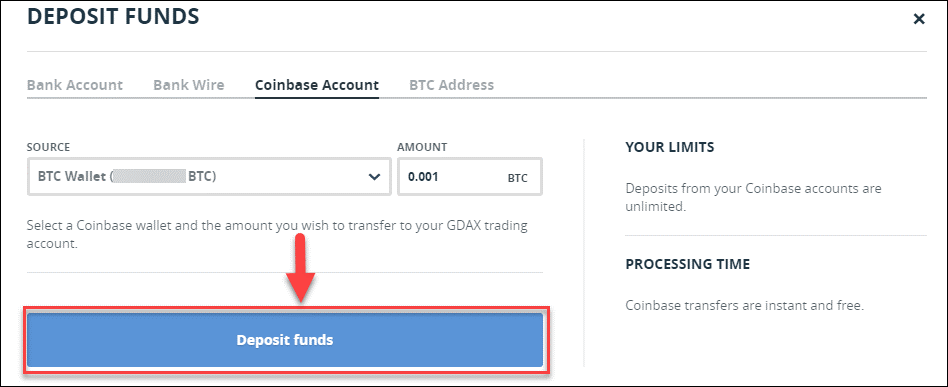
USING CRYPTOCURRENCY ADDRESS (In this example, we are considering BTC)
- Go to Gdax.com/trade
- Choose a trading pair with the currency you wish to deposit from the “select product” menu.

- If you want to deposit ETH, select ETH/USD or ETH/BTC.
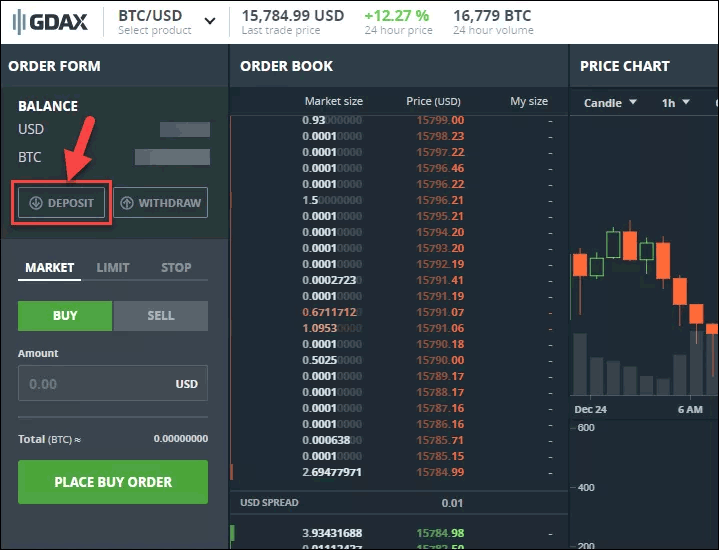
- Select the Deposit button at the top left.
- Select the “BTC address”, “BCH address”, “ETH address”, or “LTC address” tab.
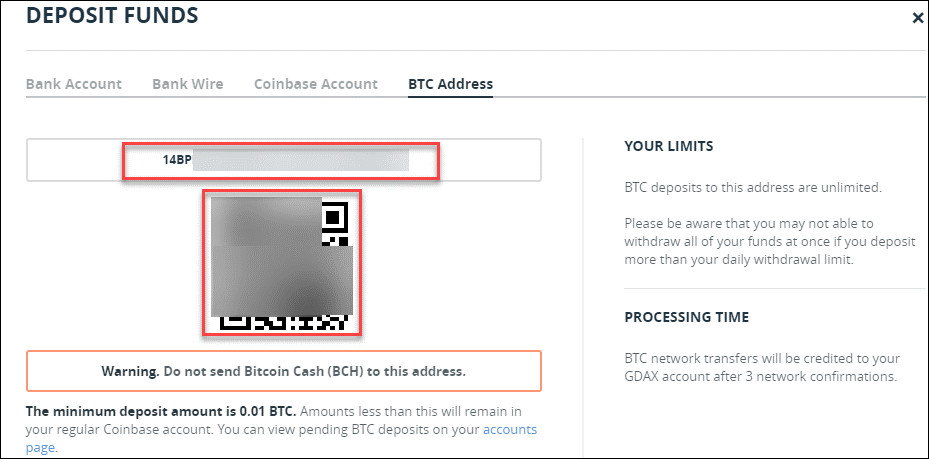
- Copy the account address shown.
- Open the external wallet you would like to deposit from, and send to the GDAX account address provided.
Trading Digital Currencies On GDAX
Now that you have your fund on the exchange, you’d like to buy BTC (or any digital currency as the case may be) on GDAX.
There are three basic ways to buy/sell a digital asset on GDAX:
1. Market Orders: 0.25% fee
This is the easiest method of executing orders on GDAX, and very similar to how orders are filled on Coinbase. A buy order can be placed at the current market price and filled immediately. This option allows traders to pay the market price as it changes. All you need do is to set the amount you want to trade, and you place your order.
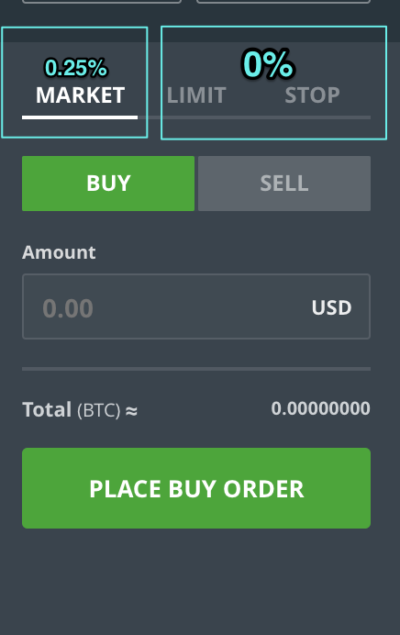
2. Limit Orders: 0% — 0.10% fee
Limit orders are the default way to buy or sell cryptocurrencies on all exchanges. Limit orders allows traders to place an order onto the order books at a specific market price you are willing to trade your assets. For example, if ETH is at $560 and you want to buy your in at $540 or lower. You should put in a limit order. If the market moves to the specified price, it becomes filled immediately. However, If the market doesn’t move to your limit level, the order won’t be filled.
A limit order is 0% fees if you are in the “taker” position. If it executes, you will pay a 0.10% fee as GDAX recognizes you as a “maker.”
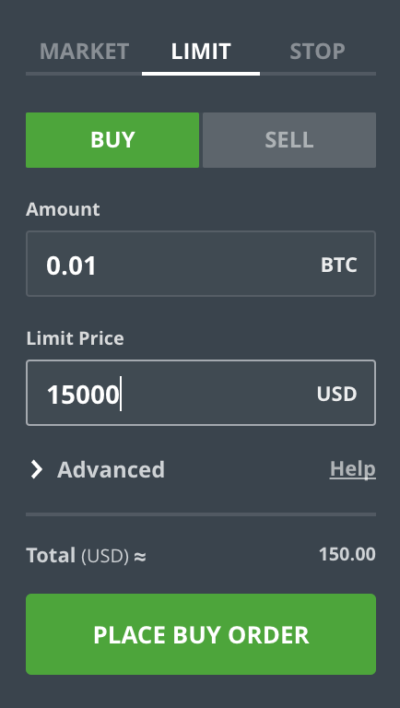
3. Stop Orders: 0% — 0.10% fee
A stop order is also known as a “stop loss” order, which allows you to minimize risk and stop your loss. This is a strategy that requires some charting or technical analysis skills. For example, if the market for BTC is at $8000 and you want to buy at $7600 or lower.
Meaning, in this case, $7600 is the starting price you’re willing to pay. If the market hits $7600, your stop order will trigger a buy at the market price until your specified amount of BTC is purchased.
4. The stop-limit buy order
This type order is the combination of the stop and limit buy to create a bracket that you’re comfortable buying in. The stop will specify the price trigger you want to start buying at. This will execute as a market buy. However, unlike the simpler stop order, the limit comes in to create a resistance of how high you’re willing to go. This alleviates your risk in case the market price shifts outside of the threshold you’re willing to trade. As an example, a stop-limit combination of the stop at $320 and the limit at $325 would allow you to execute a buy on your preferred currency only within the range. The advantage of this is that you get a very exact threshold for your price. However, your order may not be filled if the market does not hit your stop price.
Withdrawal From Your GDAX Account
- Navigate to the GDAX website and log in
- Choose the product from the drop-down list for the cryptocurrency you want to withdraw. As at the time of this writing, GDAX only accepts Bitcoin (BTC), Ethereum (ETH), Bitcoin Cash (BCC), and LiteCoin (LTC). In this example, we are choosing the BTC/USD pair because we want to withdraw the BTC.

- Click the “Withdraw” button
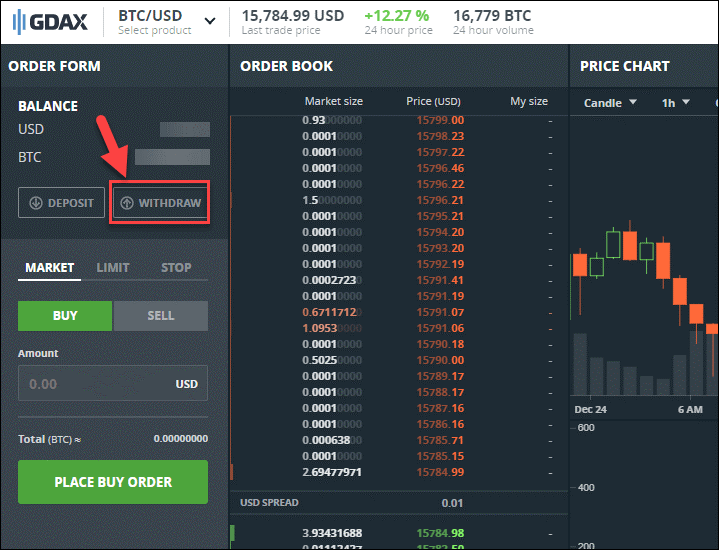
GDAX Withdrawal Methods
As described for deposit your funds on the exchange, there are also four available options for withdrawal:
- Bank Account
- Bank Wire
- Coinbase Account
- BTC/ETH/BCC/LTC Address.
Bank Account
- Enter the amount you want to withdraw, choose the bank account with which you want to receive your fund, and enter any required security information by GDAX.
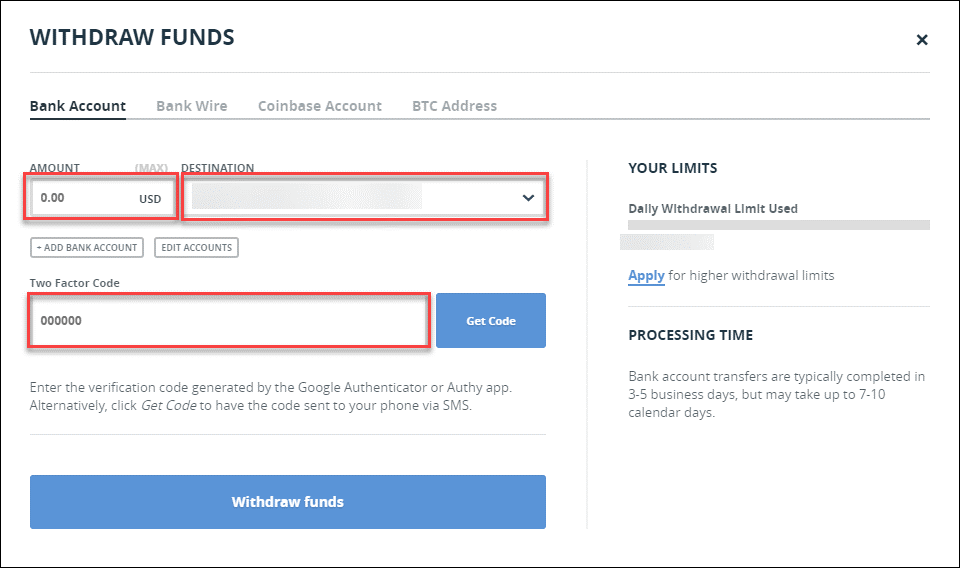
- Click the “Withdraw funds” button
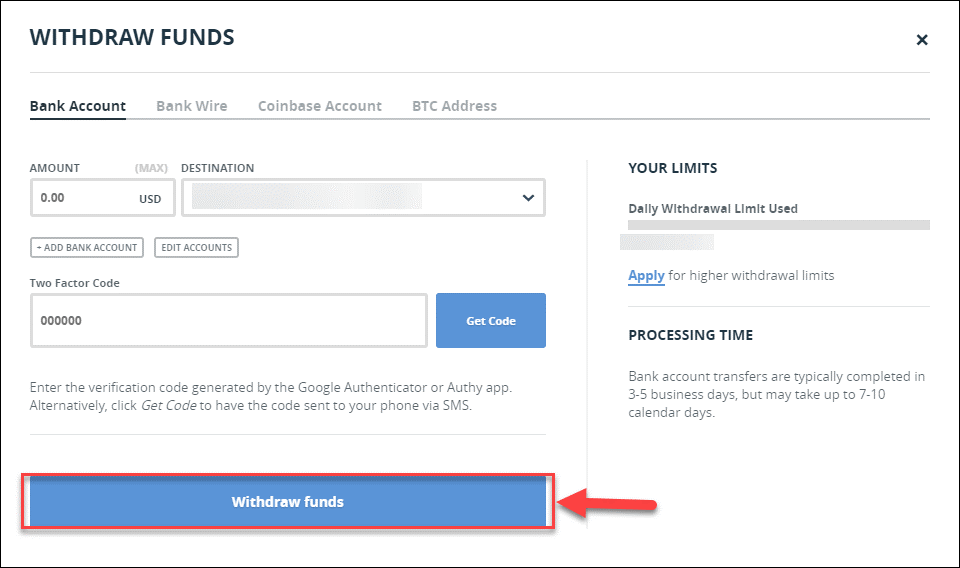
Bank Wire
- Contact your bank to get the information needed to have money wired to your account. If you do not have any wire informationon Coinbase it will prompt you to add some as shown below.
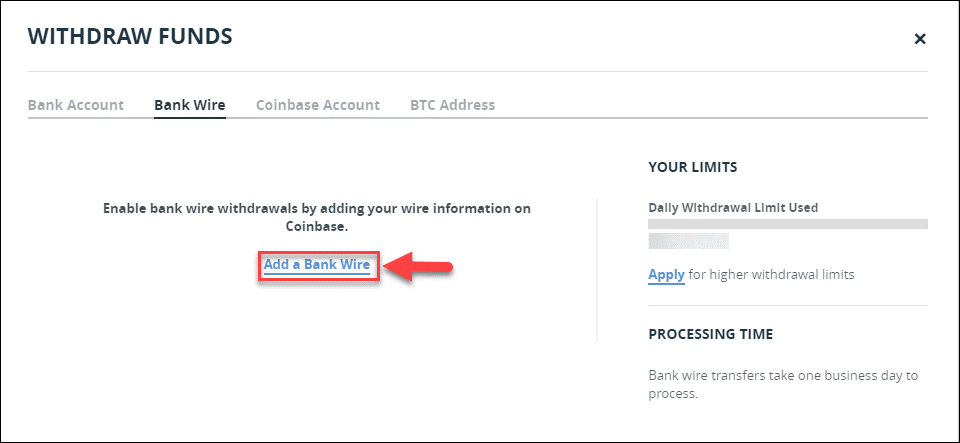
CoinBase Account
- Select the Coinbase wallet you want to transfer to and enter an amount. Note that since a BTCproduct was chosen in step 2, it will only show BTC and USD The something applies to ETH and other digital assets.
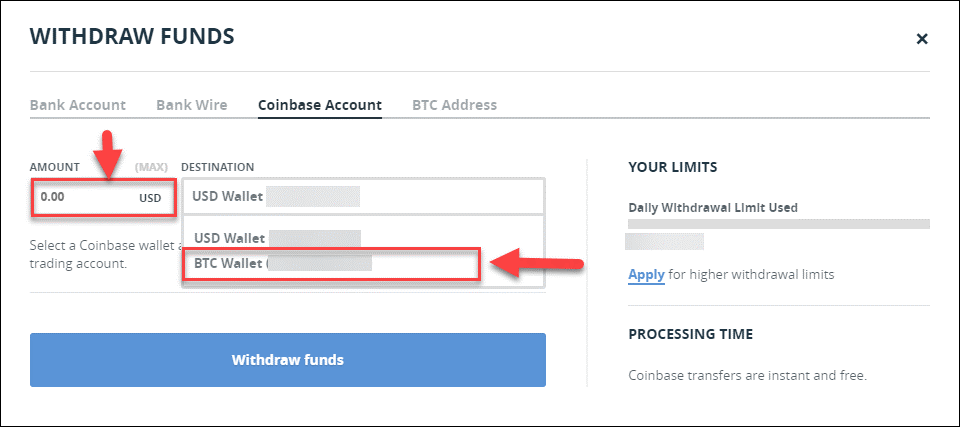
- Click the “Withdraw Funds” button.
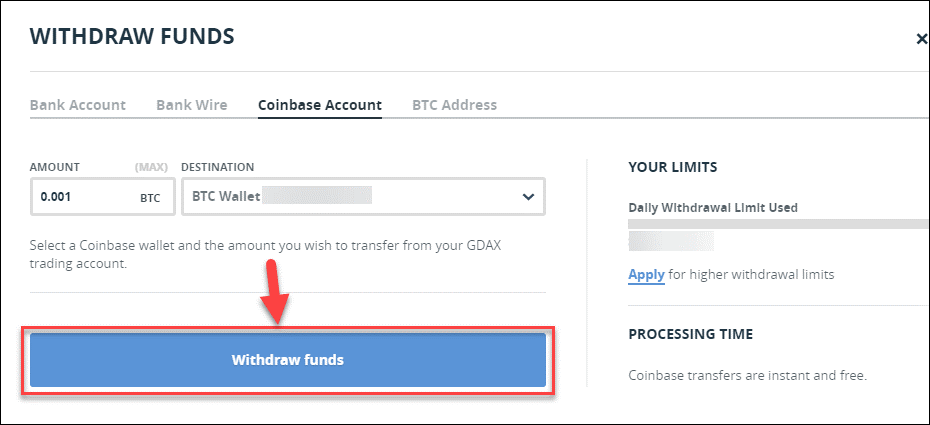
An External BTC Wallet Address
- Fill in the “Amount” and “Destination” fields. Destination will be the Bitcoin wallet you are sending funds to, and input any security information requested and then click the “Withdraw funds” button.
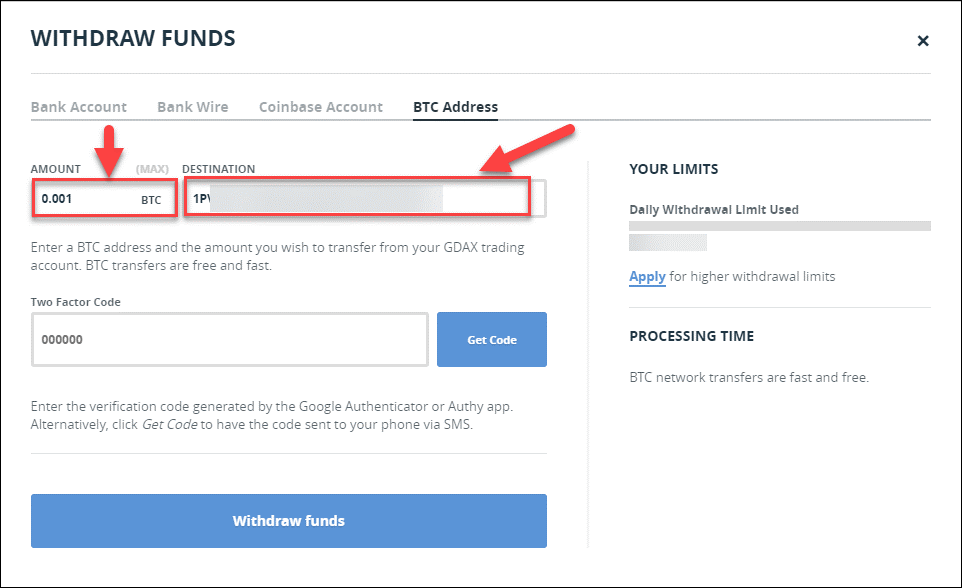
Cryptocurrency Information
Bitcoin Volumes Finally Grow Again and Bitfinex/Tether Issues Spark Systemic Risks, New Diar Report Affirms
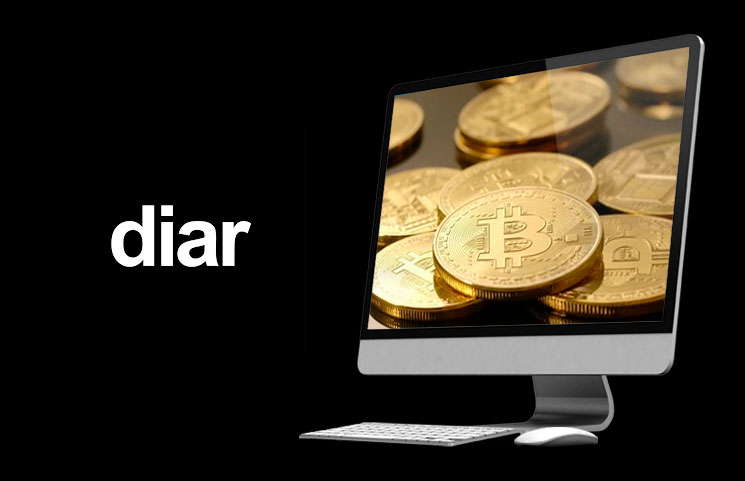
Diar has recently published its report of the crypto market for April. According to the company, Bitcoin volumes are finally growing again and the whole situation with Tether and Bitfinex showed the industry some of its systemic risks. DAI fee hikes and stablecoin projects were also highlighted in the report.
Bitcoin Goes Back To Growing Again
The main highlight of the month is, obviously, that Bitcoin is back on the action. After facing lows which started in 2018, the token has finally been able to effectively reverse the trends and have an actual price surge this month, going from less than $4,200 USD to over $5,200 USD during this short timeframe.
With this, the number of on-chain transactions has spiked for three months in a row, since prices started to get some of their value back in March and April. Now, transaction volumes are around their levels in June 2018 when the price of the asset was around $7,000 USD.
However, charts indicate that Bitcoin is yet to find more footing outside of speculative trading, so the bull market may not be as near as some think.
When looking at the volume of the whole quarters, Q1 2019 had lower volumes than Q4 2018, but Q2 2019 started considerably well.
Bitfinex and Tether Start Concerns of Systemic Risks
As you may have heard, Bitfinex was accused of using Tether funds to cover up its losses. According to Diar, there is a 26% shortfall of in-cash reserves to back Tether tokens (USDT). Tether loaned $850 million USD to Bitfinex to cover up losses and its general counsel Stuart Hoegner has affirmed that the company is operating with fewer reserves than the total market cap of the token.
This happened because Bitfinex had the $850 million USD “seized” by Crypto Capital, one of its payment processors. Unless Hoegner is lying, though, the company had the assets to back the stablecoin until recently.
While it is clear now that Tether simply does not have the money to back the funds, people simply keep buying the tokens. Now, instead of all cash, some shares of Bitfinex are being used to represent the rest of the value, which makes the stablecoin enter securities territory for the first time.
Curiously, the markets are all very tolerant now since the prices are still stable but the systemic risks are clear, especially if other companies are to follow Tether’s path.
DAI Hikes Fees Once More
Another situation highlighted by the reports is that DAI has decided to upgrade its stability fees once again as the community is desperately trying to make the prices of the so-called stablecoin go up again. DAI tokens are being sold for less than $1 USD, their official price, on secondary markets.
At the moment, the fees are 16.5%, after increasing three times in only one month. Before April, the fees were only 7.5%. This has resulted in a decrease of 4.9% in the circulation of DAI tokens.
Stablecoins Eye Wider Use Cases
Gemini and Harbor, a A16Z tokenized securities platform, have started a partnership in order to get more clients for the Harbor stablecoin. However, this was deemed “too soon” by Diar, as Harbor does not have any known token right now. The only one the company had was canceled.
TrustToken is also trying to get more stablecoins on its list, especially the ones that are not focused on USD, but on several other fiat currencies like HKD, CAD or GBP instead.
Cryptocurrency Information
#DropGold Campaign to Hit Your TV, Here’s A Breakdown of the Underlying Bitcoin Message(s)

Grayscale, a leader in digital currency investing, launched an ad on Wednesday, May 1, telling investors that money should be contributed to Bitcoin holdings as opposed to gold. In a number of interviews, CEO of Grayscale’s parent company (Digital Currency Group), Barry Silbert and Managing Director of Grayscale, Michael Sonnenshein, have since expressed the underlying message of the ad.
The #DropGold Ad
According to news outlet, U Today, the ad starts off with a man holding gold bars in his arm, which he decides to drop. While doing so, a woman also does the same. Throughout the ad, people supposedly have their gold bars stacked in shopping carts, while “losing their gold coins.” Watching what’s about to unfold, the two individuals try to find their way out.
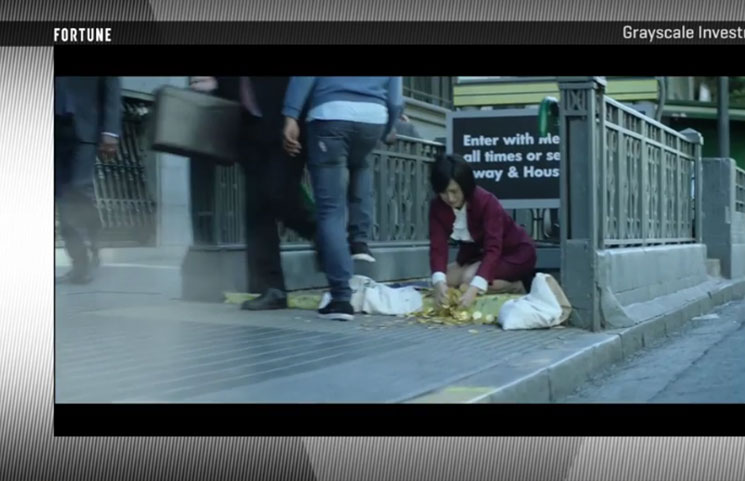
Advertising Bitcoin or Grayscale’s Services?
Despite being the one to have introduced this campaign, Silbert argues that it isn’t entirely about Grayscale services, but rather said services being a result of consumers’ decision. Yahoo Finance has since quoted the following comment made by Silbert himself:
“We do not see this as a Grayscale commercial. For us #DropGold is our ‘Got Milk’. This campaign is first and foremost focused on starting a conversation about bitcoin vs gold. If the ad makes people want to get into Bitcoin, we’re completely indifferent about how they go about doing it.”
Having said this, the commercial is evidently portraying Grayscale as an option, as towards the end, one is told, “Go Digital. Go Grayscale.”
Silbert’s and Sonnenshein’s Arguments Regarding Gold’s Limitations
Silbert believes that this campaign works towards addressing the fact that Bitcoin can serve as an equal asset class as gold, if not better. In particular, he was quoted saying, “But now you have Bitcoin, which, in our opinion, provides all the same attributes as gold – it’s fungible and scarce and you can’t counterfeit it – but the big difference is that Bitcoin has utility. Gold doesn’t have much utility beyond jewelry.”
He further argued that the goal here isn’t to replace fiat currency for shopping purposes, but rather to show the world that Bitcoin does a better job at doing gold’s job and this will be evident in the long run. Although he has acknowledged Bitcoin’s volatility as being concerning, he is hopeful that it will one day serve as both an ideal utility token and store of value.
As for Sonnenshein’s viewpoint, he sees this ad as revealing the “absurdity” associated with gold. More specifically, he said:
“We’re going after a narrative around gold being where investors should go when markets turn south or as a hedge against inflation […] we’re highlighting the absurdity of gold.”
As per The Block Crypto, Grayscale also tries to convince investors that the return earned from redistributing 5% of gold to Bitcoin will be greater than 5% yearly.
What are your overall thoughts on this ad? Did it leave you asking yourself, “Why did you invest in gold? Are you living in the past?” Share your thoughts below!
Cryptocurrency Information
Huobi Pro Bitcoin Exchange: Cryptocurrency Asset Trading Platform?
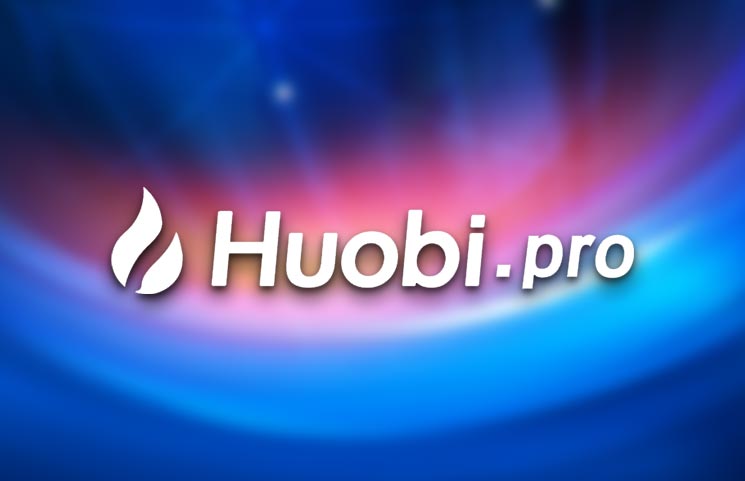
Huobi Pro Cryptocurrency Exchange
Founded in 2013, Huobi Pro allows for a myriad digital currencies to be exchanged, at a 0.2 percent trading commission. Loyal users point to the low fees and stellar service that make the exchange stand out above others.
Although pitched at dedicated cryptocurrency enthusiasts since the site doesn’t accept fiat currencies many who enter the realm on the back of fiat end up at Huobi Pro, largely due to its diverse offering and favorable fee structure.
Huobi Pro in A Nutshell

A victim of China’s clampdown on digital currencies, the company might be registered in the Seychelles, but was originally founded in Beijing. As testament to the broad appeal of the platform, after the Chinese regime effectively banned all things crypto at the beginning of 2018, trading volumes have only grown.
While at first very much a Chinese company looking at the home market, Huobi Pro has been forced to find a wider marketplace on the international scene. Indeed, even prior to the official cessation of altcoins and their trading, the company heard the rumblings in 2017 and took its cryptocurrency interests abroad.
Huobi now provides exchange services to users in over 130 countries. Company offices are located in the USA, Korea, Japan, Singapore and Hong Kong. Although the Huobi Group also owns and manages the Huobi Autonomous Digital Asset Exchange (HADAX), Huobi Pro is more of a pure “login and trade” exchange.
Users can employ network tokens to cast votes on adding new altcoins on HADAX. On the Huobi Pro exchange, a simplified offer encompassing all of the mainstream altcoins greets visitors. Some more popular coins offered are Bitcoin (BTC), Bitcoin Cash (BCH), Ethereum (ETH), Litecoin (LTC), NEM (XEM), NEO (NEO), Qtum (QTUM) and Ripple (XRP).
That said, when one actually tallies the number of altcoins available for exchange, it becomes apparent why loyal followers value the site. A marriage of both simple ease of use and diversity in trading, the platform is largely welcomed by newcomers and experienced enthusiasts alike. In the current melee of regulation being contemplated, implemented and tweaked all the while, some users may be precluded from trading on the exchange based on their country of residence.
Huobi Pro accepts the funding of accounts only in digital currencies, and accepts deposits in any of its listed altcoins. Unlike other exchanges that have opted for a midway between crypto and fiat, Huobi Pro traders deal strictly in digital coins at every point of a transaction. Funds need to be withdrawn to a wallet, and fiat users looking to buy in will have to establish a wallet first in order to fund their Huobi Pro trading account.
Traders pay a maker or taker fee of just 0.02 percent using the exchange. There are more detailed offers, worth looking at for daily traders with volume.
Huobi Pro Membership Levels
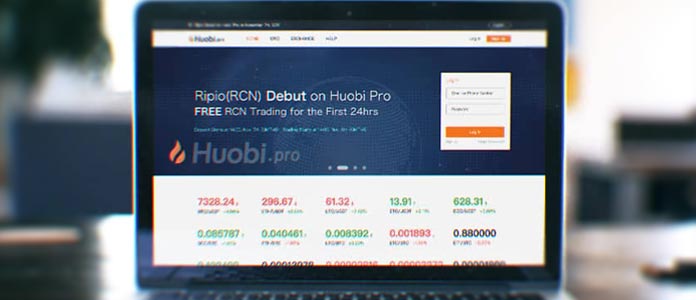
VIP users get preferential platform trading fees if they buy the privilege with Huobi tokens. The Huobi Token (HT) was never an ICO token, but rather a system token that users only obtain by buying “Point Cards” on the Huobi Pro platform. Point Card is essentially a pre-paid Huobi card that keeps users liquid on service fees. One HT = 1 USD, therefore one “point” = 1 USD. The more points purchased, the more free points are added, although savings on 1000 points, for example, means only 10 HT for free.
Huobi Global minted a fixed total of 500 million tokens, with 300 million employed to facilitate the in-house VIP structure. A mark of the business group behind the platform is seen in their practice of buying back-sold tokens from the open market each quarter. Not only that, but those funds go towards the Huobi Investor Protection Fund (HIPF).
This is a planned fund that will compensate investors who suffer platform disruption and subsequent losses. It’s a tool that minimizes risk, smooths out the market overall and also goes towards protecting investor interests. This transparent and pleasing aspect of the platform is one reason traders have confidence in the exchange, and its popularity is rising worldwide.
By way of example, in order to glean a VIP status, a trader will pay 120 HT a month for First Level membership. This enables a 20 percent discount on trading fees. Running through toward the top end, a pricier option of 6,000 HT a month secures a 50 percent discount on fees. Overall, a diligent trader can optimize the system and come out with a substantial discount on the already low 0.02 percent base offer.
The company charges no fees to deposit funds, but there are withdrawal fees. Although there are reviews online listing withdrawal fees, it appears that, especially within the membership structure, users are advised to ascertain exact fees when establishing their account. Likewise, transfer limits need to established upfront to avoid disappointment later. There exist order size limits on the platform too, again becoming more malleable as one moves up the ranks of the VIPs.
Security And UX On Huobi Pro

All of the standard protocols including two-step Google Authenticator verification are at play on the platform. Unlike many other exchanges that offer a simple crypto-exclusive platform, Huobi Pro will need your personal details in the form of a passport copy and chat room comments are not devoid of complaints, although almost all of them take issue with the structure of the platform and its potential pitfalls. There are few allegations of lost funds or other negligence on behalf of the company. On the whole, Huobi Pro seems to be rubbing off its decidedly corporate ethos onto the exchange – good news for traders overall.
Another serious boon for the cryptosphere as a whole is that over 98 percent of holdings are stored in an offline cold wallet or vault. Imbued with a strict customer service ethic, the platform probably sports the best customer service to date for crypto exchanges. Available 24/7 365, there is a live chat option onsite.
The platform intel is sufficient although newbies might have to scratch to paint a clear picture of how exactly everything works. The FAQs are thoughtful and, again, testament to a polished offering. Huobi used to be one of the biggest Chinese crypto exchanges, based in Beijing. Started by entrepreneur Leon Li in 2013, since the move there has been mutual appreciation of its value. Worldwide users have taken to the exchange, as it too realized that it had global appeal.
Huobi Pro Conclusion

Huobi claims to have exceeded BTC 500,000 in daily trading approaching 2014. Although only in its fifth year, that’s a long time in cryptocurrency. Although frequently accused of embellishing trading volumes, these allegations have never been proven. In comparison to other digital exchanges that have suffered persistent user complaints and even been shut down due to criminal activity, Huobi Pro shines.
As an offering, it has low fees, great diversity and an unbeatable crypto-energy. No trader on the platform feels like they’re missing out on something else somewhere else, by most accounts. Possibly due to their prior involvement in the fintech world, the platform got it right first time around and user numbers prove it. The company Huobi also owns another trading platform, BitYes, more focused on USD/BTC and USD/LTC pairs trading. Great customer service and minimal technical glitches have made it appear positively top-tier, again in comparison to less polished outfits.
With a detailed offering, great client liaison – very unusual for most digital exchanges so far – and no legitimate proof of anything even vaguely dark hanging about them, the Huobi Pro project is recommended. Users are advised to always ascertain costs prior to trading – not hard with the customer support in this case – and sample a platform with small trades before trading greater amounts. To learn more, you can head to their official website: huobi.pro

